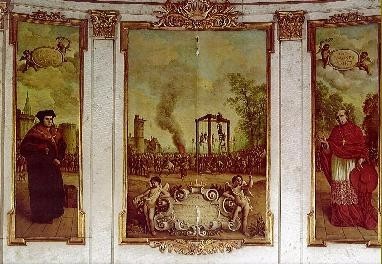St Stephen's Parish
Serving the Catholics of Skipton, Craven and the Dales
Part One: How Recusancy came about in Skipton
There was a time in this country when religion was a vigorously state-controlled affair and the term 'recusant' refers to those who refused to submit to authority and especially refused to attend the services of the established Church of England. It may be helpful to read on to understand how the Church in England came to be divided.
If you wish click here to zip forward to the founding of St Stephen's Church in the 19th century.
Christianity probably first came to England with the Romans and later with the Celts but organised efforts to bring Christianity to these shores came about when Pope St Gregory the Great sent St Augustine to the Angles in 597. The Pope had famously seen an Anglo-Saxon slave in the Roman market and said: "Non Angli sed angeli" - and sent his brother Benedictine monk, Augustine to convert the Angles and make them 'angels'.
From Canterbury, Augustine and his successors evangelised the land and established Catholic Christianity under the primacy of the Pope, Bishop of Rome and successor of St Peter. This link between England and the Apostolic See of Rome remained constant and true until the Pope deprived the Seals of Office to Thomas Cranmer in 1533. Until the 16th century, England had been Christian and Catholic for almost a millennium - as was all of Europe. There is much evidence to suggest that pre-Reformation Christianity in England was vibrant and colourful. Pilgrimages to places such as Walsingham and Canterbury and lesser shrines was popular and the veneration of saints was strong. Consequently, England has been called the 'Island of Saints' and because of her filial devotion to the Blessed Virgin Mary, England has also been called the 'Dowry of Mary'.
Of course the Church being a divine institution comprised of sinful human beings is always in need of reform and by the Renaissance there was a need for change within the Church and her structures. Martin Luther, a scrupulous German Augustinian canon was among the first to sound a call. Unfortunately his zeal for reform was so great that he severed the unity of the Church and rejected key doctrines which had been part of the Christian faith since the time of the Apostles and the Church Fathers. Those who protested against the authority of the Pope soon brought their influence to bear upon the intelligentsia of England and soon even Henry VIII - was was accorded the title of 'Defender of the Faith' by Pope Leo X in 1521 - came to question the established revelation of Christian tradition as taught by the Church. As a result of his personal dissatisfaction with his marriage and his personal interpretation of the Bible, Henry VIII, supported by Protestants at Court, finally forced through a series of Acts of Parliament. The 1534 Act of Supremacy made Henry VIII and his successors the legal Supreme Head of the Church of England. Thus England which was once part of the universal Church which acknowledged the Pope as the Vicar of Christ on earth was separated from this heritage and became a Church of its own invention. To enforce this, Parliament also passed an Act which made it treason - punishable by death - to deny him and his successors this Supremacy. Among those martyred for withholding this consent was St Thomas More, once Chancellor of Britain and St John Fisher,Cardinal-Bishop of Rochester and Henry's confessor.
Below: Ss Thomas More & John Fisher by Rex Whistler in St Wilfrid's Chapel in the Brompton Oratory, London.
Henry's initial intention was to sidestep the authority of the Pope so that he could create and dispose of his marriages as he pleased. However, a lucrative bonus was the assets of the Church including the monasteries, shrines and chantries which he seized and acquired. Most of the money he raised funded his wars in France and his princely lifestyle. Hence by 1540 England, which once was a treasure-house of monastic learning and charity, lost all these monastic resources to the royal coffers. Most of the spoils of the Dissolution sooner or later passed from the Crown to the Tudor nobility and gentry. One example is nearby Bolton Abbey. In 1170, Archbishop Thomas Becket of Canterbury had been martyred for championing the freedom of the Church from State interference. Unsurprisingly, Henry VIII strove to erase all devotion to the saint and amalgamated Church and State in England.
Thus in the 16th century, people who chose to remain faithful to the Church which their forebears had worshiped in and died for were in the dangerous situation of being opposed to the State. Most Recusant Catholics had a filial love for the king and for England but they came to demonised as insidious 'Papists' intent on destroying the State and handing England over to the Pope and the powerful Catholic enemies of England, such as Spain and France. In fact, all they really wanted was the freedom to worship God as their ancestors had and to follow the dictates of their conscience, not the Crown.
Click here for Part Two of the History of the Parish
